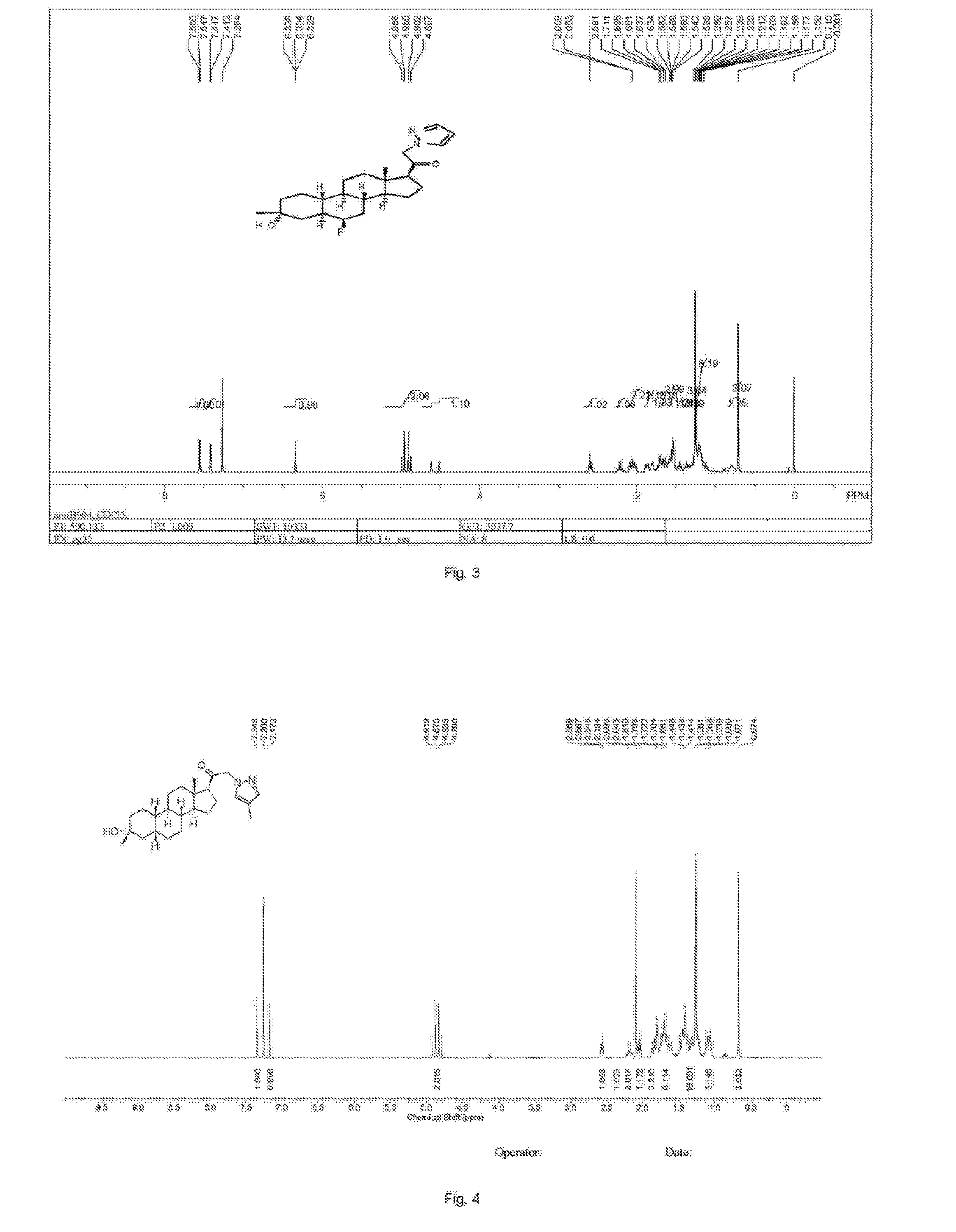19-nor C3, 3-disubstituted C21-N-pyrazolyl steroids and methods of use thereof
a technology of c21n-pyrazolyl and c3disubstituted c21n-pyrazolyl, which is applied in the field of 19-nor c3, 3disubstituted c21n-pyrazolyl steroids, can solve the problems that progesterone is not consistently effective in the treatment of the aforementioned syndromes, and achieves the effects of preventing further metabolism, reducing the potential for oxidation of the hydroxy
- Summary
- Abstract
- Description
- Claims
- Application Information
AI Technical Summary
Benefits of technology
Problems solved by technology
Method used
Image
Examples
example 1
Synthesis of SA and SA Intermediates
[0287]
Synthesis of Compound SA-B
[0288]Compound SA (50 g, 184 mmol) and palladium black (2.5 g) in tetrahydrofuran (300 mL) and concentrated hydrobromic acid (1.0 mL) was hydrogenated with 10 atm hydrogen. After stirring at room temperature for 24 h, the mixture was filtered through a pad of celite and the filtrate was concentrated in vacuo to afford the crude compound. Recrystallization from acetone gave compound SA-B (42.0 g, yield: 83.4%) as white powder.
[0289]1H NMR: (400 MHz, CDCl3) δ 2.45-2.41 (m, 1H), 2.11-3.44 (m, 2H), 3.24 (s, 3H), 2.18-2.15 (m, 1H), 2.01-1.95 (m, 1H), 1.81-1.57 (m, 7H), 1.53-1.37 (m, 7H), 1.29-1.13 (m, 3H), 1.13-0.90 (m, 2H), 0.89 (s, 3H).
Synthesis of Compound SA-C
[0290]A solution of SA-B (42.0 g, 153.06 mmol) in 600 mL anhydrous toluene was added dropwise to the methyl aluminum bis(2,6-di-tert-butyl-4-methylphenoxide (MAD) (459.19 mmol, 3.0 eq, freshly prepared) solution under N2 at −78° C. After the addition was complet...
example 2
Synthesis of SB and SB Intermediates
[0295]
Synthesis of Compounds SB-B and SB-C
[0296]Small pieces of lithium (7.63 g, 1.1 mol) were added to 2.7 L of condensed ammonia in a three neck flask at −70° C. As soon as all lithium was dissolved, the blue solution was warmed to −50° C. A solution of 19-norandrost-4-ene-3,17-dione SB-A (1, 30 g, 110 mmol) and tert-BuOH (8.14 g, 110 mmol) in 800 ml of anhydrous tetrahydrofuran was added dropwise and stirred for 90 min until the reaction mixture turned light yellow. Ammonium chloride (70 g) was added and excess ammonia was left to evaporate. The residue was extracted with 0.5N HCl (500 mL) and dichloromethane (500 mL×2). The combined organic layers were washed with saturated NaHCO3 solution, dried over Na2SO4, filtered and concentrated to give a mixture of SB-B and SB-C (21 g, 70%) which was directly used in the next step without further purification. A solution of SB-B and SB-C (21 g, 76 mmol) in 50 mL of anhydrous dichloromethane was added to...
example 3
Synthesis of SA-V Compound
[0305]
Synthesis of Compound SA-K
[0306]Compound SA-J (10 g, 36.7 mmol) was added to 50 mL acetyl chloride and 50 mL acetic anhydride. The reaction mixture was heated to 120° C. for 5 h, evaporated in vacuo to afford SA-K as a white solid (10 g, 87% yield). 1H NMR (400 MHz, CDCl3), δ (ppm), 5.78 (s, 1H), 5.55 (s, 1H), 2.4 (2H, dd), 2.13 (s, 3H), 0.90 (s, 3H).
Synthesis of Compound SA-L
[0307]To a solution of reactant SA-K (10 g, 31.8 mmol) in 200 mL THF and 20 mL H2O, was added mCPBA (11 g, 63.6 mmol) at 0° C., stirred at rt for 15 h, the reaction mixture was extracted 500 mL EtOAc, washed with 100 mL saturated Na2SO3, 100 mL saturated NaHCO3 and 100 mL brine and evaporated in vacuo then purified by silica gel flash chromatography on silica gel (Petroleum ether / ethyl acetate=5:1) to afford SA-L-1 as a white solid (2.2 g, 24% yield) (eluted first) and SA-L as the white solid (1.1 g, 12% yield) (eluted second). SA-L-1: 1H NMR (400 MHz, CDCl3), δ (ppm), 5.92 (s, 1...
PUM
 Login to View More
Login to View More Abstract
Description
Claims
Application Information
 Login to View More
Login to View More - R&D
- Intellectual Property
- Life Sciences
- Materials
- Tech Scout
- Unparalleled Data Quality
- Higher Quality Content
- 60% Fewer Hallucinations
Browse by: Latest US Patents, China's latest patents, Technical Efficacy Thesaurus, Application Domain, Technology Topic, Popular Technical Reports.
© 2025 PatSnap. All rights reserved.Legal|Privacy policy|Modern Slavery Act Transparency Statement|Sitemap|About US| Contact US: help@patsnap.com



